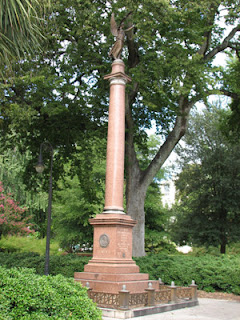several administrations, the state regent's project has been specific renovations and restorations to maintain the integrity and beauty of Tamassee's First Lady, its first building, the South Carolina Cottage. Having a special interest or project was not difference in the early years of our society. With the name of the South Carolina Cottage being the Grace Ward Calhoun Cottage, one would naturally think that Tamassee was the project during Grace Ward Calhoun's administration from 1914-1917. However, I would be remiss if I did not share with you that the vision for our mountain school was not Grace Calhoun's. To learn of Tamasssee's actual beginnings, the vision, we must step back in time even further.
This story begins in 1906 with the
administration of Virginia Mason Bratton.
During her administration, one of her objectives on the state level was to
complete the Partisan Monument located on the State House grounds. Before this project could continue, chapters
were called upon to raise funds for Continental Hall, the NSDAR original
headquarters building in Washington, D.C.
In 1908, South Carolina had raised the necessary $2000 to pay for its
beautiful exterior monolithic column – the first state to accomplish the payment.
Having met National’s requests, the state renewed its efforts to the Partisan Monument. Plans had been largely perfected during the administration of Sara Aldrich Richardson, and a substantial sum was added to that already in the bank generated during Richardson’s term; however, the project’s completion had to be turned over to Mrs. Bratton’s successor, Frances Louise Hudson Mayes.

Even though Louise Mayes was interested in all phases of patriotic work, her heart yearned toward the problem of education for the mountain children, particularly those of South Carolina. It was from her that South Carolina Daughters caught the first vision of what has developed into Tamassee DAR School. In her first address as State Regent in 1910, she said, and I quote: “Daughters of South Carolina, in my mind the problem of education for our mountaineer is our highest and noblest work. A state’s greatest asset is her educated citizenship. What a waste then, is this illiteracy among the mountain whites of our own state. It seems to me, Daughters, that this is a form of conservation that should appeal to us as an organization and one that will find a responsive chord in every womanly heart. Could I put into motion influences and project plans which would enable me to see smoke curling from a settlement school in the mountains of my state my rosiest dream will have found its full fruition.” These words falling from the lips of Frances Louise Hudson Mayes gave the inspiration for our mountain school.





